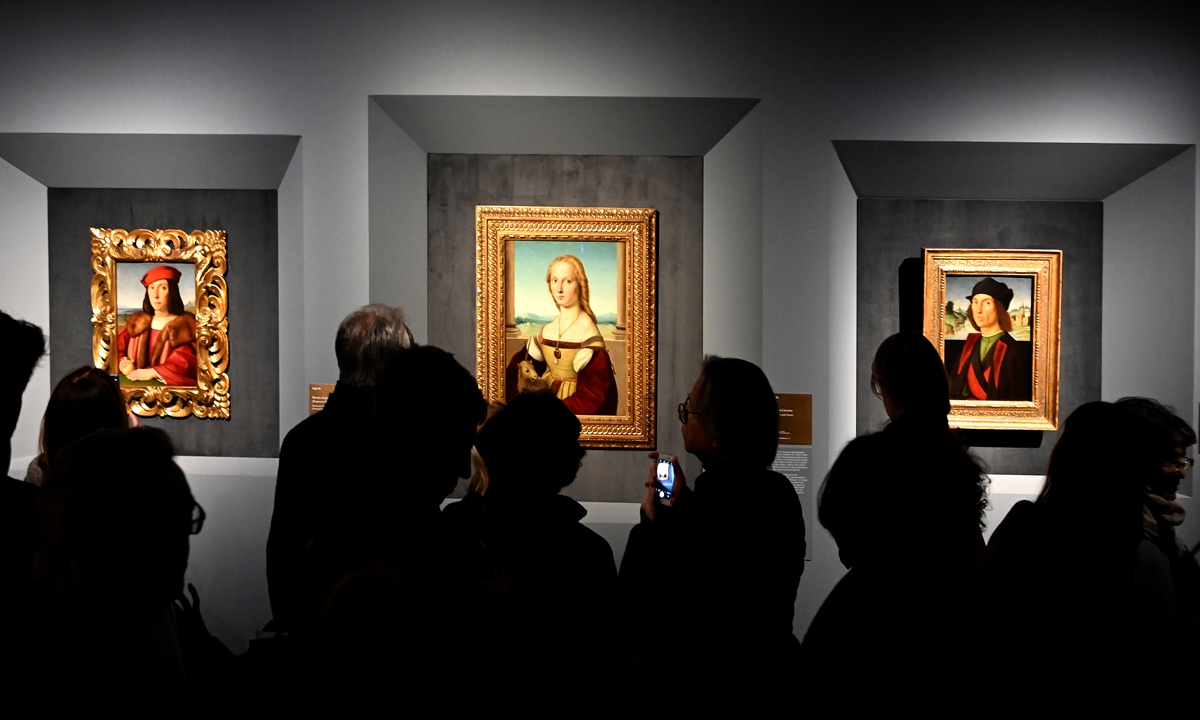Rome’s Raphael exhibition reopens with coronavirus restrictions
Source:Xinhua Published: 2020/6/4 17:53:41

Visitors look at the paintings (from left) Young Man with an Apple, Young Woman with Unicorn and Portrait of a Man by Renaissance master Raffaello Sanzio da Urbino, known as Raphael, on March 4 at the exhibition Raffaello 1520-1483 at the Scuderie del Quirinale in Rome. Photo: AFP
Nearly three months after it was shut down at the start of Italy's national coronavirus lockdown, the largest-ever retrospective of the life and work of Renaissance maestro Raphael reopened Tuesday with a choreographed trickle of visitors expected to become the new norm for public places.The Raffaello 1520-1483 exhibition at the Scuderie del Quirinale in Rome, was under development for three years, featuring works on loan from 52 different museums and collections around the world. It added up to the most comprehensive collection of the work of a painter who died at the age of 37 but who was still as acclaimed as contemporaries Leonardo da Vinci and Michelangelo.
The exhibition opened amid great fanfare on March 5, but was forced to close days later when Italy announced Europe's first nationwide coronavirus lockdown.
The exhibit reopened Tuesday with the opening-day fanfare replaced by a methodical entry scheme designed to assure social distancing. Visitors, who had to wear face masks, were required to reserve precise entry times. Each visitor had his or her temperature taken by a digital thermometer upon entry.
Organizers allowed one group of six visitors to enter every five minutes and each group was given five minutes in each of 10 halls featuring a period of Raphael's works and objects important to his career, starting from his death 500 years ago and going back to his youth. A bell chimed at the end of each five-minute period to let each group know when it was time to move on to the next hall.
"It may seem a little mechanical, but it is what we needed to do to allow people to enjoy the exhibition safely," Matteo Lafranconi, co-curator of the landmark retrospective, told the Xinhua News Agency. Lafranconi personally greeted many of the groups coming to the exhibition on the first day.
"We're thrilled we were able to make it work out," he said, a reference to the challenge of convincing museums and curators of private collections to extend the loan of Raphael's works for an additional three months. In the end, Lafranconi said, every single lender agreed.
Tuesday had originally been scheduled to be the closing day for the exhibition, which has now been extended to August 30.
On a busy day before the global coronavirus outbreak, the Scuderie del Quirinale museum could host as many as 5,000 visitors. Now, even with extended hours, the daily number will not surpass 800, museum officials told Xinhua.
Museum curators and directors have said this new kind of opening strategy is likely to be the norm as long as coronavirus remains a threat. But visitors to the Raphael exhibition on Tuesday said they did not mind the new rules.
"It's very different to visit a museum in this way, but everything is very different if you compare it to before the lockdown," Antonia Esposito, a retired office worker, said in an interview.
"Coming here feels a lot more normal than going to a restaurant or a hair salon these days. I have no complaints. I'm thankful to be able to come here."
Theresa Verratti, a high school history teacher, agreed.
"I've spent the last two or three months teaching classes online," Verratti told Xinhua.
"It feels like a luxury to actually see these beautiful works of art in real life and not in a book or on a computer screen."
The reopening coincided with Italy's Republic Day, which marks the 74th anniversary of the national referendum that created Italy's post-World War II republic, and it comes a day before the country opens its borders to restriction-free tourist arrivals from 25 Schengen countries.
Newspaper headline: Making it work
Posted in: ART,CULTURE & LEISURE,ARTS FOCUS